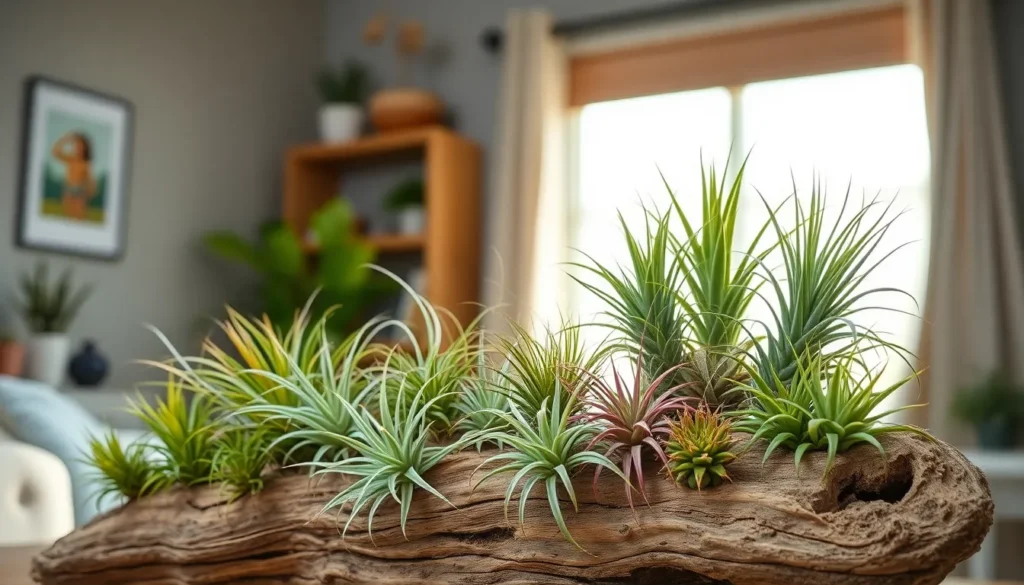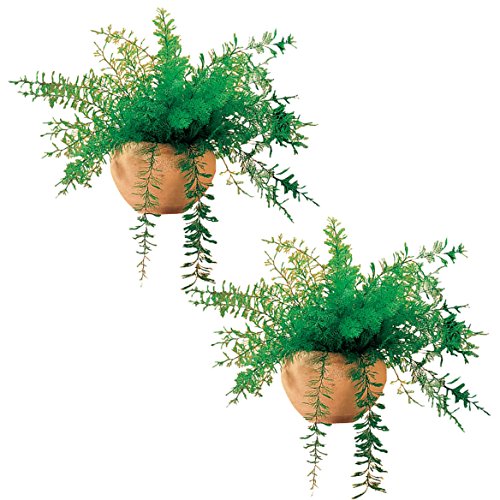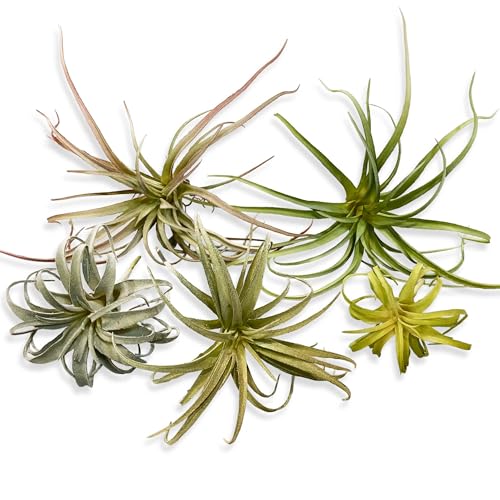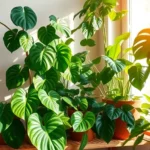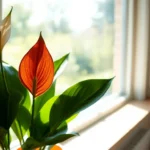We’ve all been there – watching houseplants wither away even though our best efforts to keep them alive. If you’re tired of dealing with soil mess and complicated watering schedules, air plants might be your perfect solution.
Air plants, scientifically known as Tillandsia, are fascinating creatures that don’t need soil to thrive. These remarkable plants absorb nutrients and moisture directly from the air around them, making them incredibly low-maintenance additions to any space. We’re seeing more plant enthusiasts discover these unique beauties as they transform homes and offices with minimal effort.
From busy professionals to frequent travelers, air plants offer benefits that traditional houseplants simply can’t match. Whether you’re looking to purify your indoor air, add stunning visual appeal, or finally succeed with plant parenthood, these resilient plants deliver results that’ll surprise you.
Air Plants Require No Soil for Growth
Unlike traditional houseplants that depend on soil for nutrients, air plants break free from this constraint entirely. We can enjoy the beauty of greenery without dealing with messy potting soil or worrying about drainage issues.
Freedom from Traditional Potting
Eliminating soil removes the hassle of repotting and root maintenance. We don’t need to worry about choosing the right soil mixture, checking pH levels, or dealing with overwatering that leads to root rot. Air plants absorb all their nutrients directly from the atmosphere through specialized scales called trichomes on their leaves.
Pest problems become virtually nonexistent without soil as a breeding ground. Traditional potted plants often harbor fungus gnats, spider mites, and other insects that thrive in moist soil environments. Air plants eliminate these concerns since there’s no soil medium for pests to colonize or reproduce in.
Watering becomes more controlled and less messy. We simply mist our air plants 2-3 times per week or give them a weekly 20-minute soak in room temperature water. There’s no risk of water spilling from drainage holes or creating water damage on furniture surfaces.
Easy Relocation and Display Options
Moving air plants requires no careful handling of heavy pots or soil spillage. We can instantly relocate them from room to room, take them outdoors for better air circulation, or bring them along when traveling. Their lightweight nature makes transportation effortless compared to traditional potted plants.
Creative display possibilities become unlimited without pot restrictions. We can mount air plants on driftwood, place them in glass terrariums, hang them from macrame holders, or attach them to living walls. Popular display methods include mounting on cork bark, placing in geometric glass containers, or creating hanging installations with fishing line.
Seasonal decorating becomes more flexible with portable air plants. We can easily incorporate them into holiday displays, wedding centerpieces, or temporary art installations. Their ability to thrive in various locations means we’re not committed to permanent placement like we would be with soil-based plants.
Air Plants Need Minimal Watering
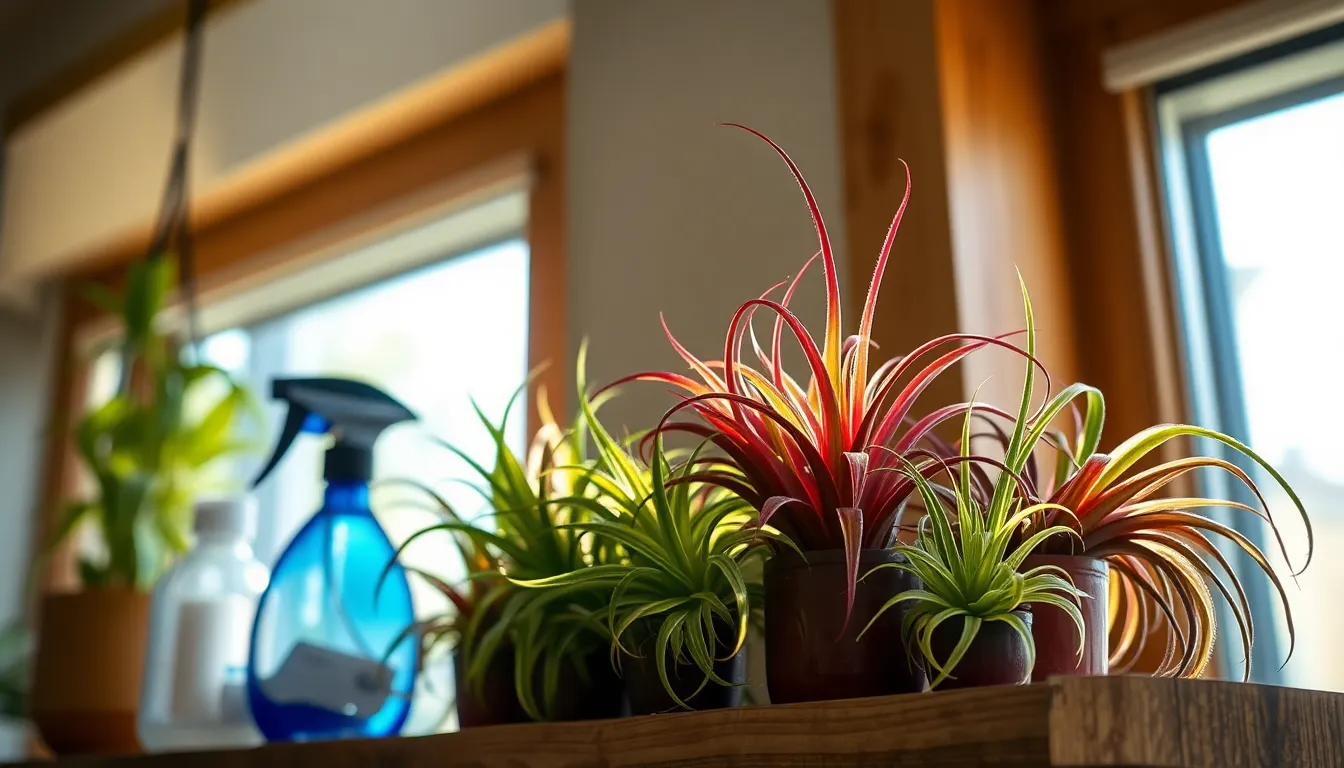
Water conservation becomes effortless with Tillandsia species, as these remarkable plants require significantly less moisture than traditional houseplants. We’ve discovered that air plants absorb water and nutrients directly through their specialized leaf scales rather than through root systems like conventional plants.
Simple Misting Requirements
Misting your air plants 2-3 times per week provides all the hydration they need to thrive indoors. We recommend using a spray bottle to lightly mist the leaves until they appear damp but not soaked. Room temperature water works best for this gentle watering method, and morning misting allows proper air circulation for drying.
Weekly soaking offers an alternative approach where we submerge the entire plant in water for 20-30 minutes before allowing it to dry completely. This technique works particularly well for air plants in drier climates or heated indoor environments. We find that combining occasional soaking with regular misting creates the ideal moisture balance.
The beauty of air plant care lies in its simplicity since we don’t need complex watering schedules or soil moisture monitoring. Their natural ability to absorb atmospheric moisture means they can survive periods of neglect better than most houseplants.
Reduced Risk of Overwatering
Overwatering becomes nearly impossible with air plants since they don’t have traditional root systems that can develop rot. We’ve seen countless plant enthusiasts struggle with killing plants through excessive watering, but Tillandsia species eliminate this common gardening mistake.
Root rot, the leading cause of houseplant death, simply doesn’t affect air plants because they lack soil-based root systems. We appreciate how this characteristic makes air plants ideal for beginners who tend to water too frequently. Their resilient nature allows them to bounce back from occasional watering mistakes.
Signs of overwatering in air plants include soft, mushy leaves or a rotting smell, but these issues occur far less frequently than with potted plants. We recommend allowing air plants to dry completely between waterings to maintain their health and prevent any moisture-related problems.
The forgiving nature of air plants means we can travel for extended periods without worrying about returning to dead or dying plants from water stress.
Air Plants Purify Indoor Air Quality
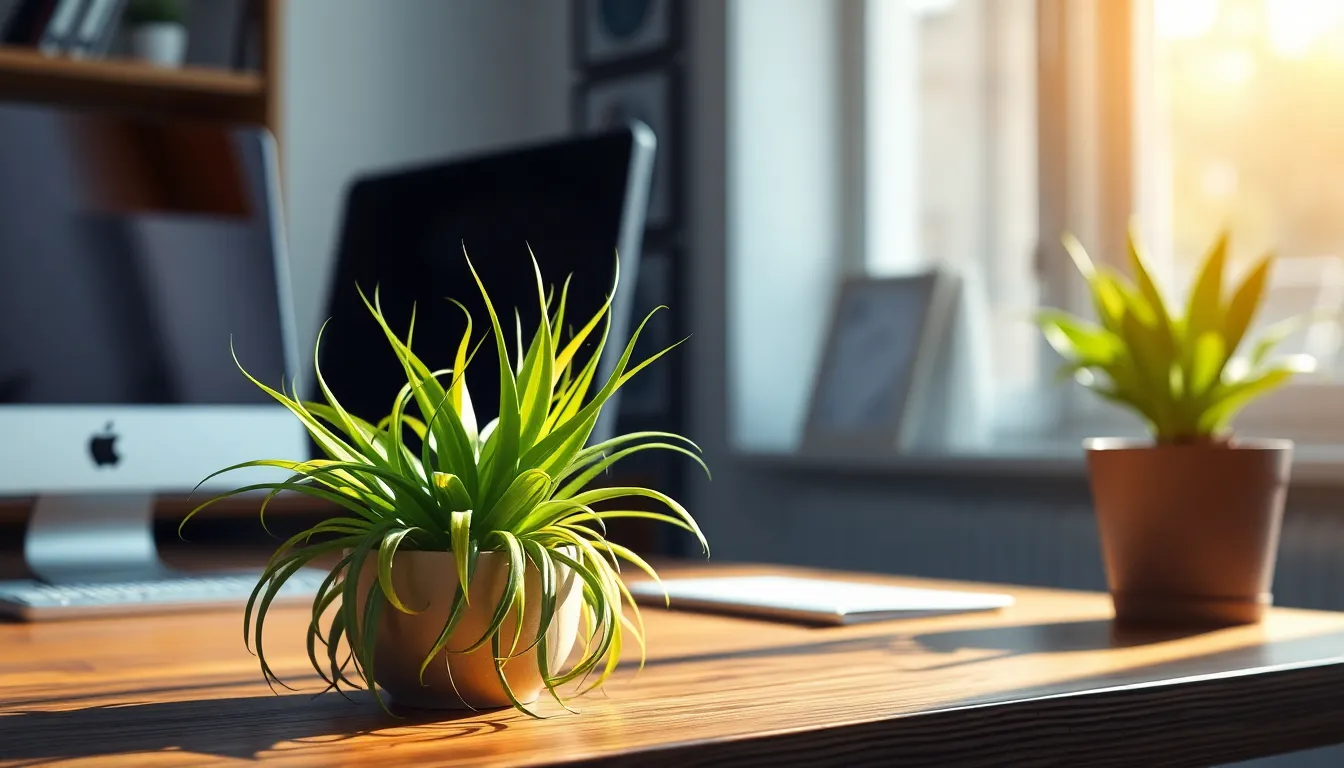
Beyond their low maintenance appeal, air plants offer remarkable benefits for our indoor environment through their natural air cleaning abilities.
Natural Air Filtration System
Air plants function as living air purifiers by absorbing carbon dioxide during the day and releasing fresh oxygen back into our spaces. Their unique leaf structure contains specialized scales called trichomes that capture airborne particles and pollutants as they absorb moisture from the atmosphere. We can think of each air plant as a miniature biological filtration unit that works continuously without electricity or replacement filters.
These epiphytes enhance our indoor air quality through natural biological processes that traditional air purifiers can’t replicate. Unlike mechanical systems that simply move air around, air plants actively transform the chemical composition of our breathing space. The effectiveness varies based on the exact tillandsia species we choose and the size of our rooms, but even a small collection can contribute to cleaner indoor air.
Removal of Harmful Chemicals
Air plants help eliminate certain chemical pollutants that commonly accumulate in our homes and offices from cleaning products, furniture, and building materials. While they’re not as powerful as dedicated air purification systems, these natural cleaners can absorb and neutralize various airborne toxins through their leaf surfaces. Research shows that air plants contribute to reducing indoor pollution levels, though their effectiveness depends on factors like plant density and room ventilation.
Office environments particularly benefit from air plants’ chemical removal capabilities, as these spaces often contain higher concentrations of pollutants from electronics, carpeting, and synthetic materials. We can strategically place multiple air plants throughout our workspace to create zones of cleaner air that may boost productivity and reduce headaches or fatigue. Even compact varieties like Tillandsia ionantha can make a measurable difference in small spaces like cubicles or home offices where air circulation might be limited.
Air Plants Offer Versatile Decorating Options
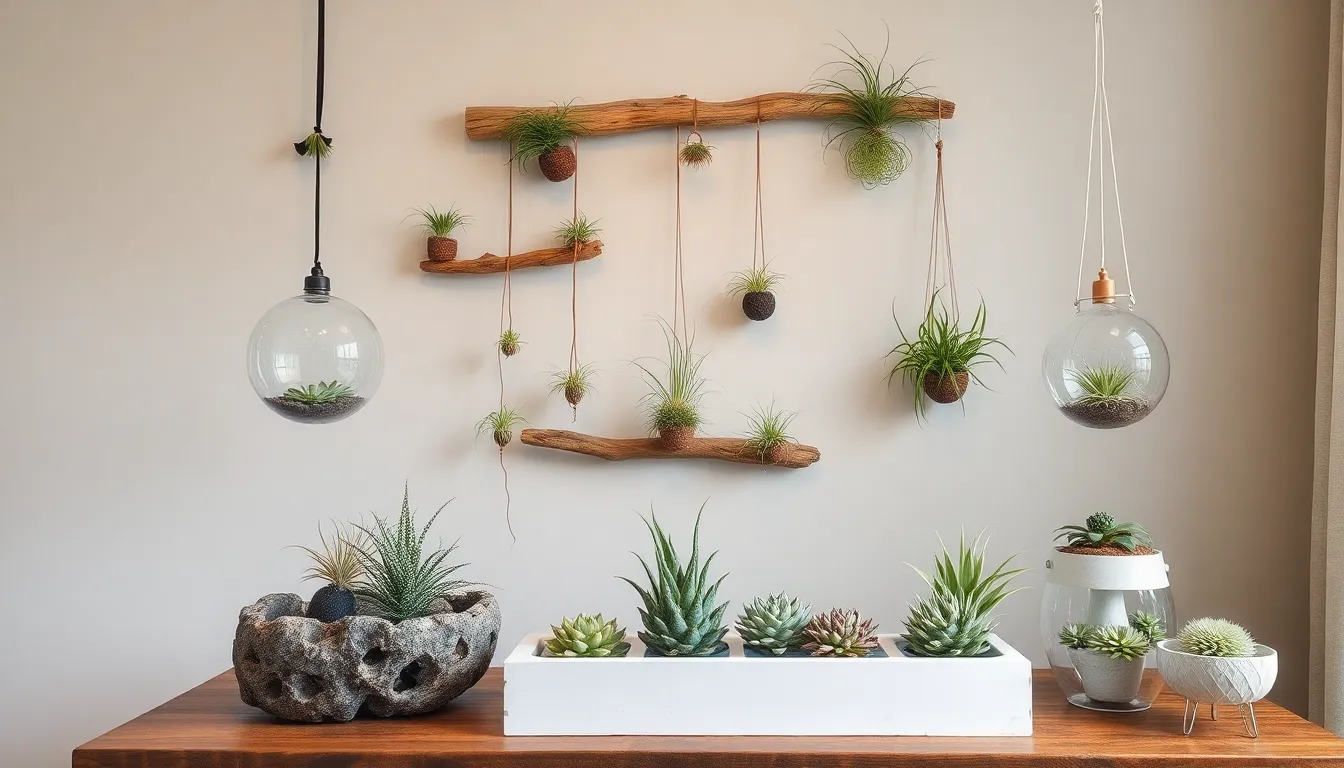
Unlike traditional houseplants that require pots and soil, air plants give us unlimited creative freedom in decorating our spaces. Their unique soil-free nature opens up decorating possibilities that simply aren’t available with conventional plants.
Creative Display Possibilities
Suspended displays create stunning visual impact when we hang air plants from ceilings using fishing line or decorative chains. Glass globes and repurposed glassware serve as elegant containers that showcase the intricate leaf patterns while adding sophistication to any room. We can mount them directly onto driftwood pieces, creating natural sculptures that bring organic texture to walls and shelves.
Grouped arrangements work beautifully when we cluster multiple air plant varieties together in shallow bowls or on floating shelves. Terrariums offer another creative outlet, allowing us to build miniature ecosystems using sand, decorative stones, and colorful air plants of different sizes. We can even incorporate them into existing art pieces or create living walls by attaching them to mesh panels or cork boards.
Seasonal decorating becomes effortless since we can easily move air plants without worrying about soil spillage or root damage. Holiday displays, wedding centerpieces, and special event decorations all benefit from air plants’ portability and unique appearance.
Perfect for Small Spaces
Compact living benefits tremendously from air plants since they thrive in bright, indirect light without taking up valuable floor space. Apartment dwellers can place them on windowsills, bathroom shelves, or kitchen counters where traditional potted plants might overwhelm the area. We can maximize vertical space by creating hanging gardens that don’t compete with furniture or walking areas.
Minimal footprint makes air plants ideal for studio apartments, tiny homes, and small offices where every square inch matters. They add that essential touch of greenery to compact areas without the bulk of traditional planters or the maintenance requirements of soil-based plants. We can rotate them seasonally between different small spaces, keeping our decorating fresh and ever-changing.
Flexible placement options mean we’re not limited by drainage concerns or exact pot sizes that might not fit our small space constraints.
Air Plants Provide Low-Maintenance Care
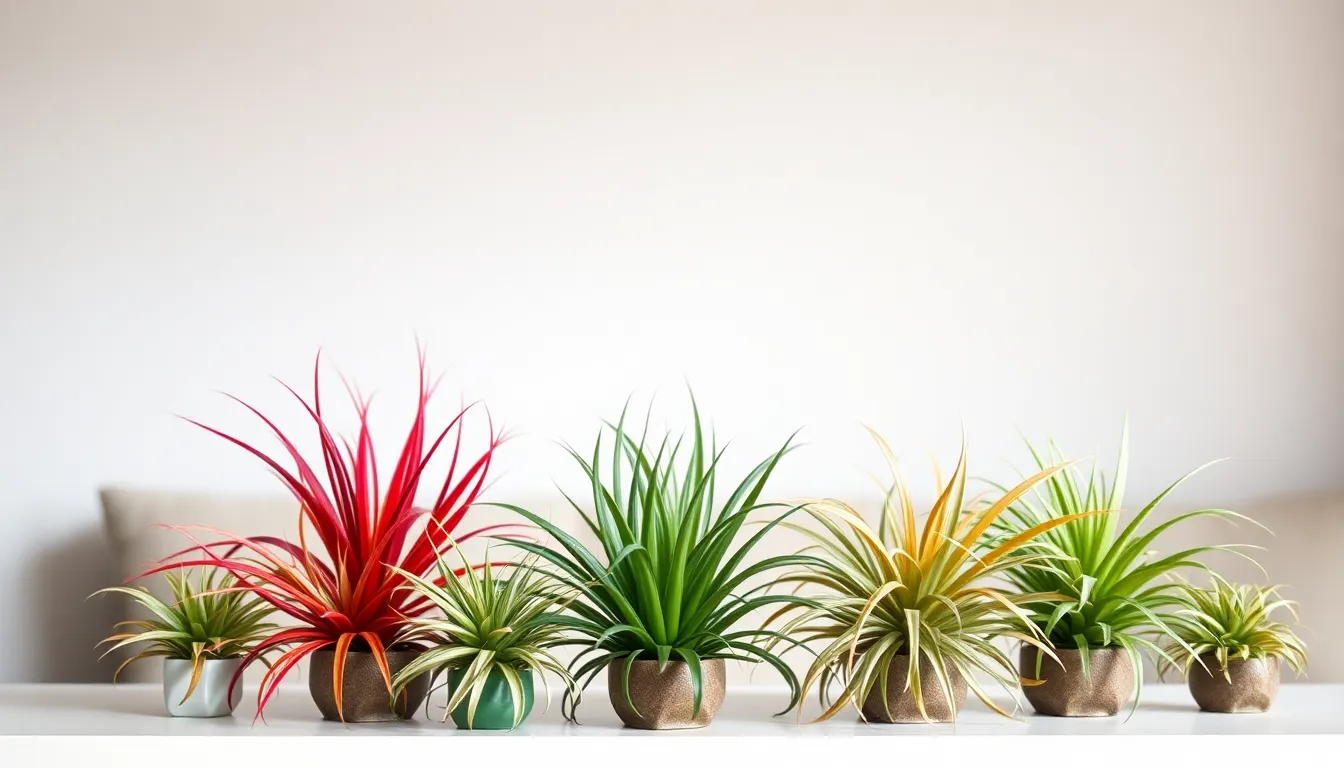
Air plants stand out as the ultimate solution for plant lovers who crave greenery without the typical gardening commitments. These remarkable Tillandsia species require minimal intervention while delivering maximum visual impact.
Ideal for Busy Lifestyles
Minimal watering schedules make air plants perfect for professionals juggling demanding careers. We only need to mist them 2-3 times per week with room temperature water, eliminating daily plant care routines that overwhelm busy schedules.
Travel friendly characteristics ensure our air plants survive extended absences without specialized care arrangements. They can tolerate periods of neglect that would kill traditional houseplants, making them ideal for frequent travelers or those with unpredictable work schedules.
No soil maintenance removes the messiest aspects of plant ownership from our routines. We never deal with repotting, fertilizing schedules, or soil related pest problems that plague conventional indoor gardens.
Flexible placement options allow us to relocate air plants instantly without soil spillage or heavy containers. This lightweight portability means we can redecorate spaces seasonally or move plants to optimize lighting conditions effortlessly.
Beginner-Friendly Plant Option
Forgiving nature makes air plants nearly impossible to kill through common beginner mistakes. Their specialized leaf scales absorb nutrients directly from the atmosphere, reducing our chances of overfeeding or underfeeding these resilient plants.
Simple care requirements eliminate complex gardening knowledge from successful air plant ownership. We don’t need to understand soil pH levels, drainage systems, or fertilizer ratios that intimidate new plant parents.
Overwatering immunity protects air plants from the most common houseplant killer since they lack traditional root systems. This characteristic removes the guesswork from watering schedules that typically destroy beginner plant collections.
Cost effective investment makes air plants an affordable entry point into indoor gardening. Their long lasting nature and low maintenance requirements mean we spend less money replacing failed plants or purchasing specialized care products.
Air Plants Thrive in Various Light Conditions
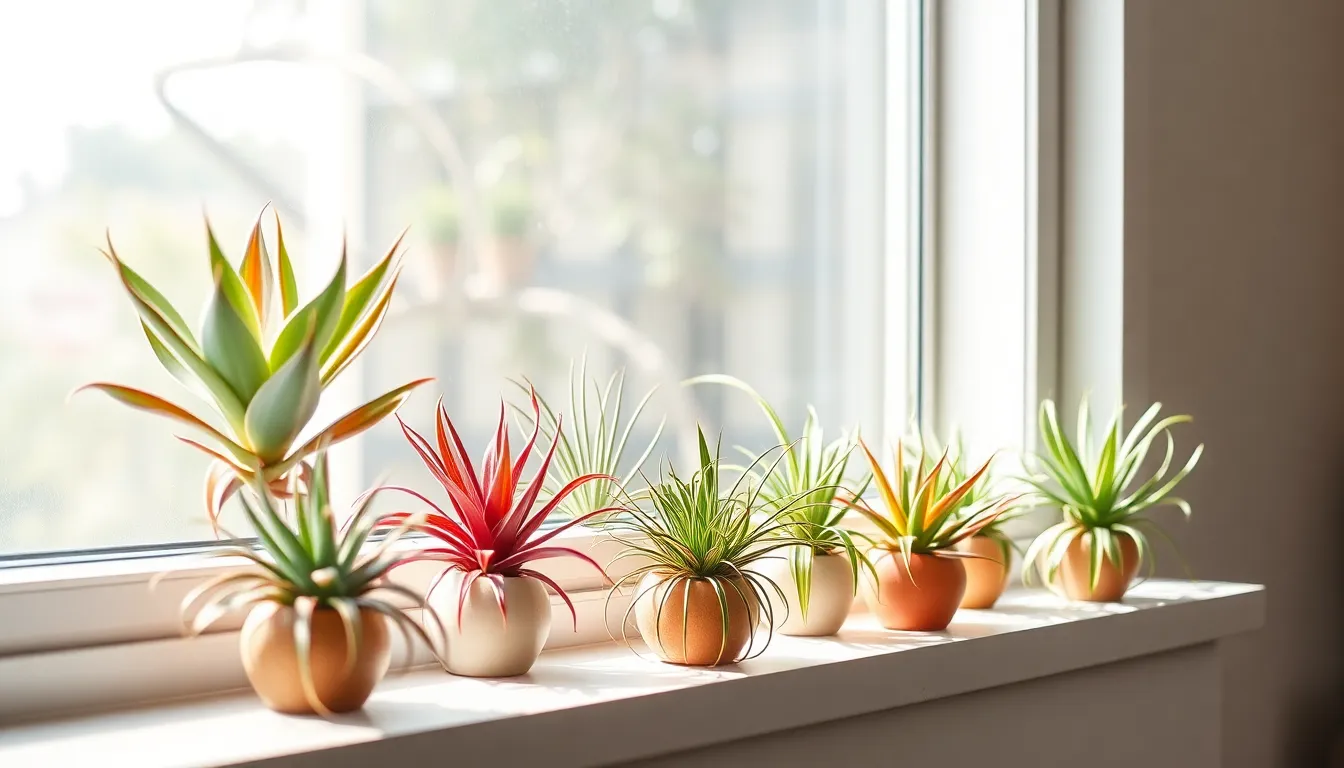
Air plants offer remarkable flexibility when it comes to lighting requirements, making them perfect for almost any indoor space. We can place these adaptable plants in locations where traditional houseplants would struggle to survive.
Adaptable to Indoor Lighting
Versatility shines through air plants’ ability to flourish under artificial lighting conditions that would challenge most houseplants. Office environments with fluorescent lighting provide sufficient illumination for healthy air plant growth, eliminating concerns about inadequate natural light sources. Bright filtered sunlight through windows creates optimal conditions without requiring exact positioning near glass surfaces.
Flexibility extends to various indoor lighting scenarios, from well-lit living rooms to moderately bright bathrooms and bedrooms. We can successfully grow air plants under LED bulbs, making them suitable for spaces without windows or adequate natural lighting. Room lighting that supports comfortable reading typically provides enough illumination for air plants to photosynthesize effectively.
Tolerance for different light intensities means we don’t need to worry about precise lighting measurements or complex positioning strategies. Air plants adapt to seasonal lighting changes throughout the year without requiring relocation or supplemental lighting systems. Their resilience allows placement in areas with varying light patterns throughout the day.
No Direct Sunlight Requirements
Protection from harsh direct sunlight actually benefits air plants more than constant sun exposure, which can damage their delicate leaf structures. We can confidently place air plants away from south-facing windows where intense afternoon sun might scorch their leaves. Filtered light through curtains or blinds creates ideal growing conditions without the risk of overexposure.
Freedom from direct sunlight requirements opens up countless placement options throughout our homes and offices. North-facing windows provide gentle, consistent lighting that air plants prefer over intense direct rays. Indoor locations several feet away from windows still receive adequate light levels for healthy air plant development.
Convenience comes from not needing to monitor sun patterns or rotate plants to prevent uneven growth from directional lighting. We can focus on creative display options rather than worrying about optimal sun exposure throughout different seasons. Their preference for indirect lighting makes air plants ideal companions for spaces where direct sunlight creates uncomfortable heat or glare conditions.
Air Plants Reproduce Naturally Through Pups
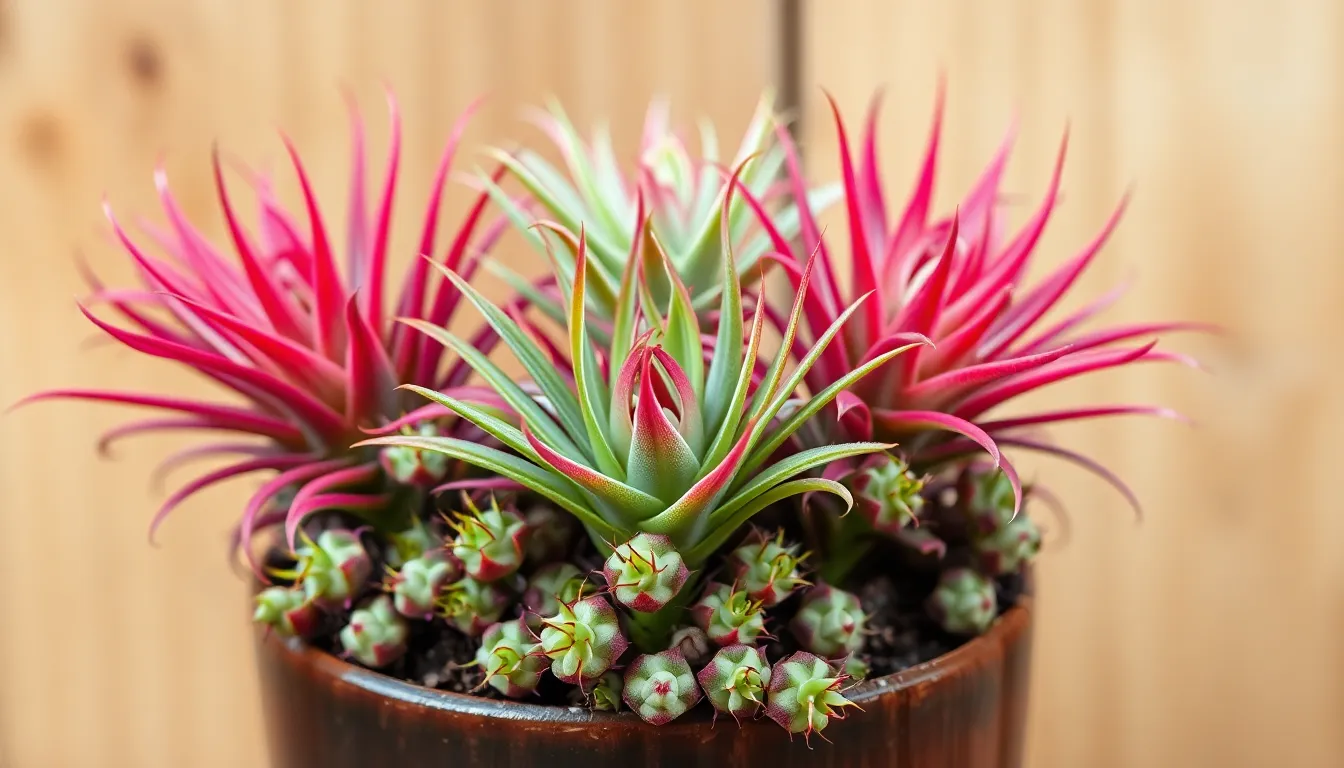
Air plants create new plants automatically through their unique propagation process. We don’t need to purchase seeds or complicated propagation equipment to expand our collection.
Self-Propagating Plant Benefits
Natural reproduction happens when air plants form “pups” or offsets around their base. These small clones develop their own root systems and leaves while remaining attached to the mother plant. We can separate these pups once they reach about one-third the size of the parent plant.
Growing new plants requires no special skills or gardening experience. The mother plant handles all the complex biological processes needed to create healthy offspring. We simply wait for nature to take its course and provide basic care to both plants.
Timing of separation gives us flexibility in managing our plant collection. Pups can remain attached for months without harming either plant, allowing us to choose when we want to expand our display. We can also leave multiple pups attached to create fuller, bushier arrangements.
Success rates for propagation reach nearly 100% when we follow basic guidelines. Each pup inherits the same hardy characteristics as its parent, making them just as resilient and low maintenance. We don’t face the uncertainty common with other plant propagation methods.
Cost-Effective Plant Collection
Expanding our air plant collection costs virtually nothing after the initial purchase. A single air plant can produce multiple pups throughout its lifetime, essentially giving us free plants year after year. We avoid the recurring expense of buying new plants or propagation supplies.
Multiple generations of plants develop from one original specimen. Each pup can eventually produce its own offspring, creating an endless cycle of new plants. We can build substantial collections that would otherwise cost hundreds of dollars in retail purchases.
Sharing plants with friends becomes effortless when we have surplus pups. We can give away healthy plants without depleting our own collection, making air plants perfect for plant swaps or gifts. This social aspect adds value beyond the monetary savings.
Investment value increases over time as our collection multiplies. While traditional houseplants may die and require replacement, air plants continue generating new specimens. We essentially get a return on our initial plant investment through natural propagation.
Air Plants Create Unique Living Art Displays
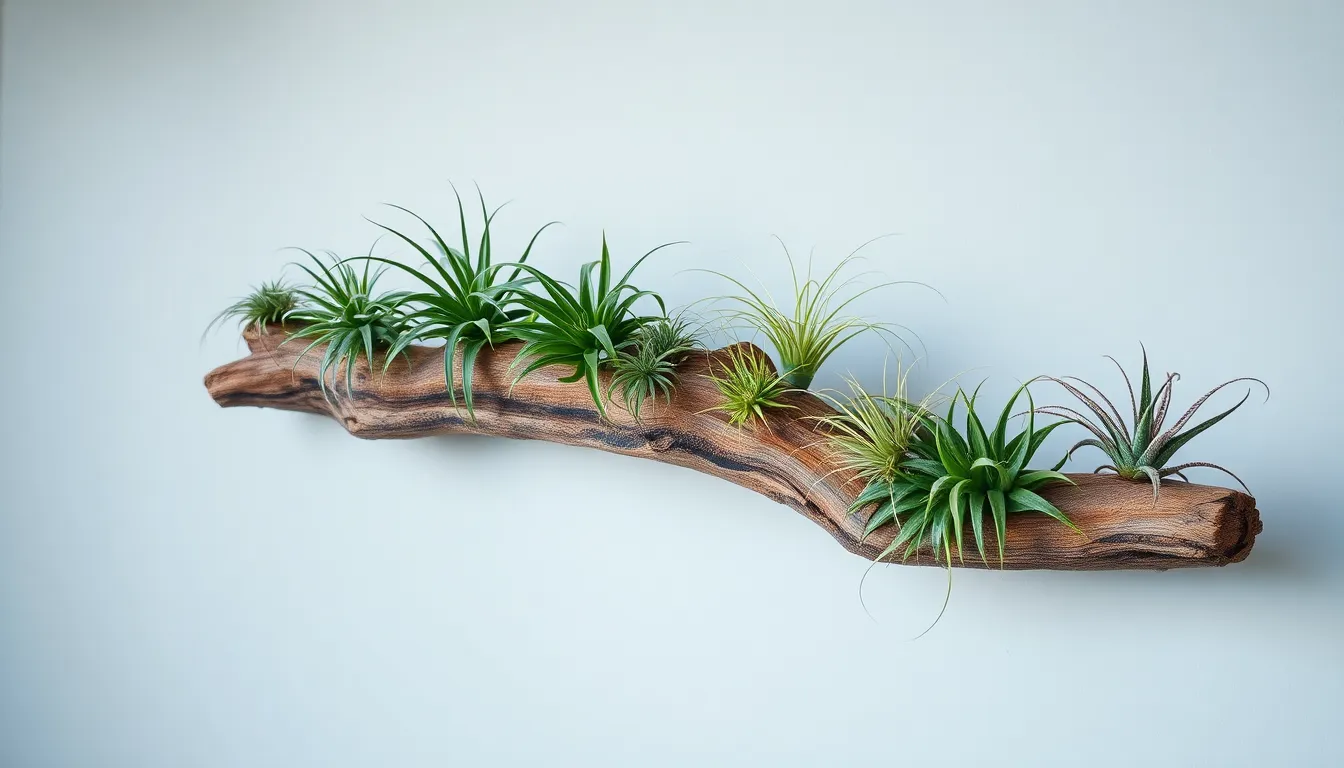
Air plants transform ordinary spaces into extraordinary visual experiences through their natural sculptural qualities and Instagram-ready appeal.
Sculptural Plant Arrangements
Creating three-dimensional botanical masterpieces becomes effortless with air plants’ naturally artistic forms. Their diverse shapes range from spiky rosettes to cascading tendrils, allowing us to create stunning focal points that rival traditional sculptures. We can suspend clusters of Tillandsia xerographica from ceiling beams to create dramatic overhead installations that draw the eye upward and add vertical interest to any room.
Mounting air plants on driftwood pieces produces organic art installations that celebrate natural textures and forms. The contrast between weathered wood and silvery air plant foliage creates visual depth that enhances both rustic and modern interior styles. We can arrange multiple species with varying heights and textures on a single piece of driftwood to establish captivating displays that serve as conversation starters.
Geometric arrangements using wire frames or modern stands transform air plants into contemporary art pieces. These structured displays highlight the plants’ unique ability to thrive without traditional containers while creating clean lines that complement minimalist decor. We can group different Tillandsia varieties within geometric holders to achieve museum-quality installations that elevate our living spaces.
Instagram-Worthy Home Decor
Glass terrariums showcase air plants’ ethereal beauty while creating picture-perfect moments for social media sharing. These transparent vessels allow us to observe every detail of our air plants while protecting them from dust and creating controlled microclimates. We can layer colored sand, decorative stones, or crystals within glass globes to enhance the visual appeal and create stunning photography opportunities.
Hanging gardens using macrame holders or copper wire create dreamy floating displays that photograph beautifully. The combination of trailing air plants and artisanal hangers produces bohemian-inspired vignettes that instantly upgrade our home’s aesthetic appeal. We can arrange multiple hanging planters at varying heights to create dimensional wall art that looks professionally designed.
Living walls constructed with air plants offer endless creative possibilities for statement-making home decor. These vertical gardens can be customized using reclaimed wood, metal grids, or artistic frameworks to match our personal style preferences. We can incorporate different air plant species with complementary colors and textures to create gradient effects or pattern-based designs that photograph exceptionally well for social media content.
Air Plants Boost Mental Health and Well-Being
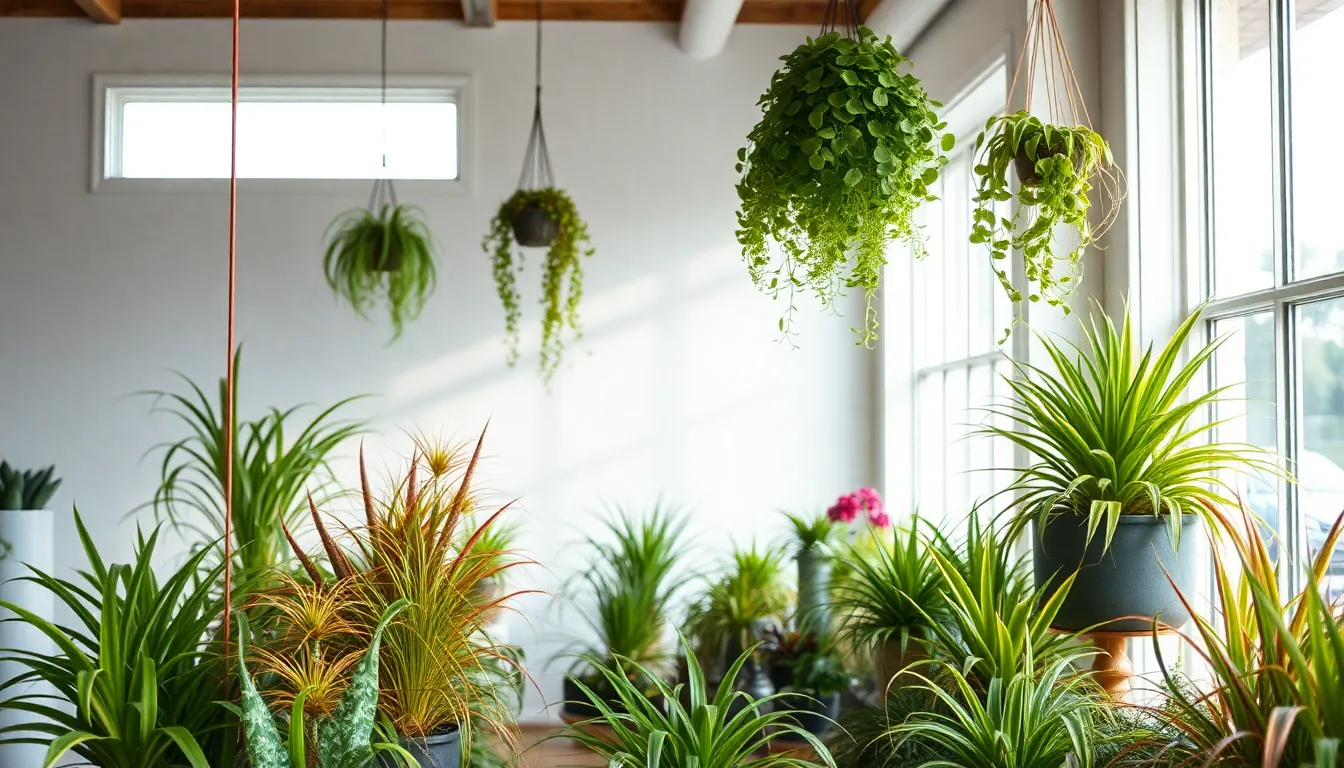
Beyond their decorative appeal and easy care, air plants offer important mental health benefits that make them valuable additions to our indoor spaces. Research reveals that these remarkable plants can positively impact our psychological well-being in measurable ways.
Stress Reduction Benefits
Air plants naturally reduce cortisol levels in our bodies, which leads to decreased stress and anxiety throughout the day. Studies demonstrate that exposure to tillandsia and other houseplants can lower these stress hormones significantly, creating a calmer environment in our homes and workplaces.
Mood improvement occurs when we surround ourselves with air plants, as they help reduce symptoms of depression and promote emotional stability. The presence of these living plants triggers positive psychological responses that can enhance our overall mental state and emotional resilience.
Accessibility makes air plants particularly effective for stress relief since their low maintenance requirements mean we don’t need to worry about complex care routines. Their forgiving nature eliminates the anxiety that often comes with traditional plant ownership, allowing us to enjoy their benefits without additional stress.
Connection with Nature Indoors
Biophilia, our innate love for living things, gets activated when we incorporate air plants into our indoor environments. This natural connection stimulates feelings of calm and well-being that can significantly impact our mental health, even in urban settings where access to nature may be limited.
Cognitive function improvements occur when we place air plants throughout our living and working spaces. Research shows that surrounding ourselves with plants like tillandsia can enhance focus, productivity, and mental clarity, making them valuable additions to home offices and study areas.
Enhanced aesthetic appeal from air plants creates visually pleasing environments that boost feelings of happiness and relaxation. Their unique sculptural qualities and versatile display options allow us to create personalized spaces that reflect our style while supporting our mental wellness.
Conclusion
Air plants represent a game-changing approach to indoor gardening that we can all embrace regardless of our experience level or lifestyle demands. They’ve proven themselves as the perfect solution for anyone seeking the joy and benefits of greenery without traditional plant care complexities.
We’ve discovered that these remarkable plants offer far more than just low-maintenance appeal. From their natural air-purifying abilities to their stress-reducing properties and endless creative display possibilities air plants deliver comprehensive value that extends well beyond basic plant ownership.
Whether you’re a busy professional frequent traveler or complete beginner looking to start your plant journey air plants provide the ideal foundation. Their forgiving nature combined with their ability to thrive in various lighting conditions and reproduce naturally makes them an investment that continues giving back over time.
Frequently Asked Questions
What are air plants and how are they different from regular houseplants?
Air plants, or Tillandsia, are unique plants that grow without soil and absorb all their nutrients and moisture directly from the air through specialized scales on their leaves. Unlike traditional houseplants that require potting soil, regular watering schedules, and root maintenance, air plants are completely soil-free and much easier to care for.
How often do I need to water air plants?
Air plants require minimal watering – simply mist them 2-3 times per week with room temperature water. In drier climates, you can alternatively soak them in water once weekly. This eliminates the need for complex watering schedules or soil moisture monitoring that traditional plants require.
Can air plants survive if I travel frequently or have a busy schedule?
Yes, air plants are perfect for frequent travelers and busy professionals. Their forgiving nature allows them to survive periods of neglect, and their simple care requirements mean they won’t die from common mistakes like overwatering. They only need misting a few times per week, making them ideal for unpredictable schedules.
Do air plants really purify the air in my home?
Air plants do help purify indoor air by absorbing carbon dioxide and releasing fresh oxygen while capturing some airborne particles and pollutants. However, they’re not as powerful as dedicated air purification systems. They function more like miniature biological filters that can contribute to slightly cleaner indoor air.
What kind of lighting do air plants need?
Air plants are very flexible with lighting conditions and thrive under artificial lighting like fluorescent and LED bulbs. They prefer indirect light and should be kept away from direct sunlight, which can damage their leaves. This adaptability makes them suitable for various indoor spaces without constant light monitoring.
How can I display air plants creatively in my home?
Air plants offer unlimited decorating possibilities since they don’t need pots or soil. You can suspend them from ceilings, display them in glass globes, mount them on driftwood, create geometric arrangements, or build living walls. Their lightweight and portable nature makes seasonal redecorating effortless and allows for Instagram-worthy displays.
Do air plants reproduce and can I grow more from one plant?
Yes, air plants naturally reproduce by forming “pups” or offsets around their base. Once these pups reach about one-third the size of the parent plant, they can be separated to create new plants. This self-propagation makes air plants cost-effective and allows you to expand your collection or share with friends.
Are air plants good for mental health and stress relief?
Research shows that air plants can help reduce cortisol levels, leading to decreased stress and anxiety. Their presence improves mood, emotional stability, and cognitive function while activating our natural connection to nature. Their low-maintenance nature makes them particularly effective for stress relief without the anxiety of traditional plant care.

